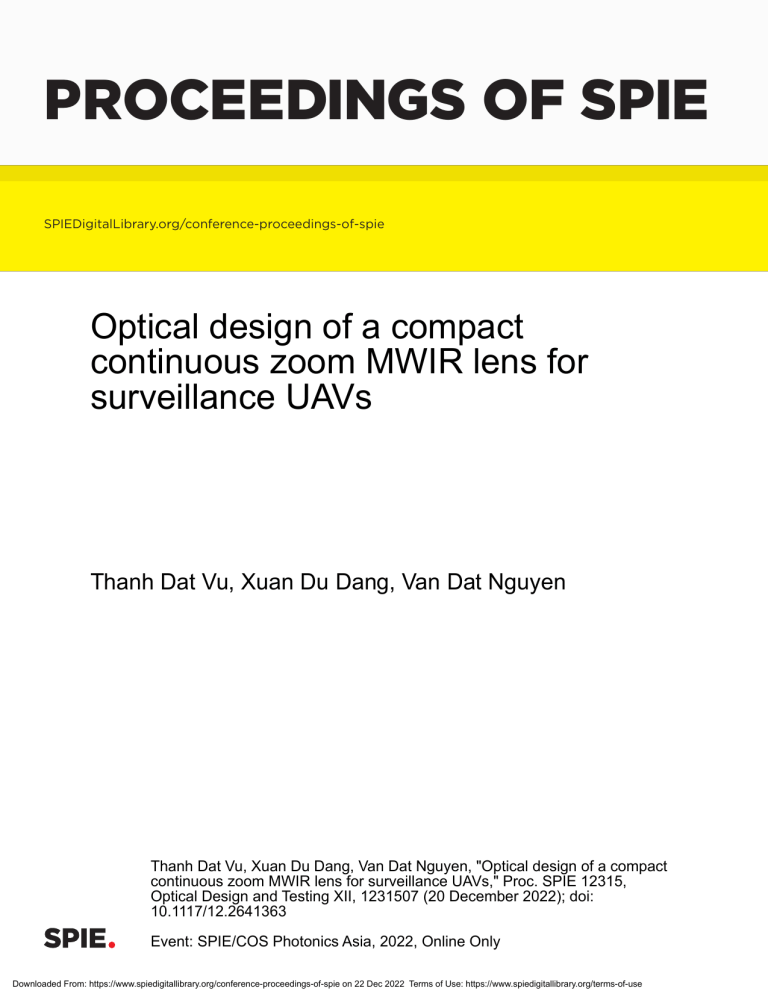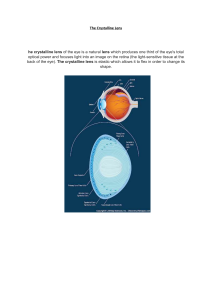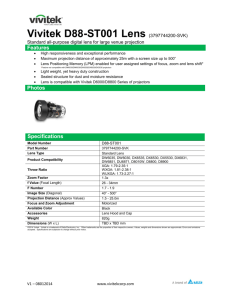
PROCEEDINGS OF SPIE SPIEDigitalLibrary.org/conference-proceedings-of-spie Optical design of a compact continuous zoom MWIR lens for surveillance UAVs Thanh Dat Vu, Xuan Du Dang, Van Dat Nguyen Thanh Dat Vu, Xuan Du Dang, Van Dat Nguyen, "Optical design of a compact continuous zoom MWIR lens for surveillance UAVs," Proc. SPIE 12315, Optical Design and Testing XII, 1231507 (20 December 2022); doi: 10.1117/12.2641363 Event: SPIE/COS Photonics Asia, 2022, Online Only Downloaded From: https://www.spiedigitallibrary.org/conference-proceedings-of-spie on 22 Dec 2022 Terms of Use: https://www.spiedigitallibrary.org/terms-of-use Optical design of a compact continuous zoom MWIR lens for surveillance UAVs Vu Thanh Dat, Dang Xuan Du, Nguyen Van Dat Electro-Optics Center, Viettel Hi-Tech Industries Corporation Viettel Tower, Hoa Lac Hi-Tech Park, Thach That District, Hanoi, Vietnam ABSTRACT This paper describes an optical design of a compact continuous zoom mid-wave infrared (MWIR) lens for use with today’s infrared detector technologies. The developed design is applicable in industries where system size becomes a critical factor, including unmanned aerial systems (UAS), unmanned aerial vehicles (UAV) and drone payloads. By applying optical design principles such as power distribution via element bending, element splitting and aberration balancing, a continuous zoom MWIR lens was successfully designed. It has a focal length range of 20 – 275 mm, which translates to a magnification ratio of almost 14x. The IR detector type that is compatible with the developed design is a VGA (640 x 512) high operating temperature (HOT) MWIR focal plane array (FPA) having a pixel pitch of 15 μm and an aperture of F/5.5. While a standard MWIR FPA is usually sensitive to a spectral range of 3.7 – 4.8 μm, a HOT MWIR FPA is responsive to a spectral range of 3.7 – 4.2 μm. This is also the limits which the optical design discussed in this paper was optimized for. Overall, the continuous zoom MWIR lens managed to maintain its high level of imaging performance throughout the prescription zoom range, all of which is contained within a compact package under 100 mm in length. With its long target detection range, the developed design is highly suitable for surveillance UAV payloads as well as other relevant aerial systems on the market. Keywords: Continuous zoom lens, Compact optical design, MWIR, Infrared optics, UAV applications 1. INTRODUCTION In recent years, infrared (IR) imaging applications have seen significant growth and development. What comes with it is an increasing need for reduced Size, Weight and Power (SWaP) optical systems [1]. In particular, applications such as UAV and drone optics are showing a tendency toward more highly advanced thermal imaging systems. In most cases, they usually feature IR detectors that have larger formats and smaller pixel sizes. This presents many challenges for the optical designer because while the optical performance has to be sufficiently optimized for a higher detector resolution and a larger image size, the optical assembly will also have to be compact, lightweight and have an efficient power usage in order to maximize airborne time. In other words, the optical design is required to deliver a crisp image quality and a diffraction-limited MTF over the entire zoom range while meeting strict SWaP requirements [2]. It is also preferred that the optics have the capabilities to withstand harsh environmental operating conditions associated to the UAV and drone applications. In this work, such an infrared imaging system has been successfully designed for surveillance UAVs. It is a continuous zoom MWIR lens with a magnification ratio of approximately 14x and it is compatible with VGA HOT MWIR detectors on the market that has a cut-off wavelength of 4.2 µm. Further details, specifications and performance will be discussed in the following sections. 2. OPTICAL DESIGN 2.1 System Specifications Nowadays, most counter systems for UAVs and drones on the market are equipped with a detection radar and possibly an advanced long-range multi-spectral camera system. Usually, they have the capabilities to detect small consumer-grade unmanned aerial systems (UAS) at a distance from 8 to 10 kilometers [3] and neutralize these targets up to 5 kilometers away via soft-kill and/or hard-kill countermeasures [4]. This provides the optical designer with the minimum target detection range in order to ensure the surveillance UAV is operating in a safe environment where the probability of opposition interference or elimination is negligible. After analyzing and inspecting relevant SWaP optical assemblies on the market, the specifications of the continuous zoom MWIR lens were proposed in Table 1. Optical Design and Testing XII, edited by Yongtian Wang, Tina E. Kidger, Rengmao Wu, Proc. of SPIE Vol. 12315, 1231507 · © 2022 SPIE · 0277-786X · doi: 10.1117/12.2641363 Proc. of SPIE Vol. 12315 1231507-1 Downloaded From: https://www.spiedigitallibrary.org/conference-proceedings-of-spie on 22 Dec 2022 Terms of Use: https://www.spiedigitallibrary.org/terms-of-use Figure 1. Capabilities of current counter unmanned aerial system (C-UAS). Table 1. Specifications of the MWIR continuous zoom lens. Ever since the 1950s, with the development of opto-mechanical technologies, precise cam curves were introduced to the public, allowing multiple lens groups with different optical powers to be controlled independently. It was from this period that the mechanically-compensated zoom lens has become the go-to solution for complicated continuous zoom optical designs. However, multiple free-moving elements also meant that there were numerous choices of power configuration, each with different optical properties and magnification capability. For two powered lens groups, it was found that the N-P power configuration to be the best solution, providing following designs with a basic and fundamental structure [5]. In this configuration, if the direction from the object space toward the image space is considered forward then the first lens group after the front objective lens group along the optical axis is going to have a negative optical power and is responsible for the change of overall system magnification. Meanwhile, the defocus effect caused by that change is going to be compensated by the following lens group, which has a positive optical power. These two lens groups are usually referred to as “variator” and “compensator”, respectively [6]. With this power configuration, the sizes of all moving elements are kept small, which is highly desired in order to achieve a high magnification ratio and a compact overall system. According to the Johnson criteria for thermal imaging cameras, it was analysed that for a certain number of resolvable bar cycles corresponding to the critical dimension of the target, a target detection, recognition or identification task may be accomplished at a probability [7], which is indicated in Table 2. A bar cycle consists of a bar and a space with the same widths. From these criteria, the theoretical range for successful task accomplishment can be calculated as the following equation. Proc. of SPIE Vol. 12315 1231507-2 Downloaded From: https://www.spiedigitallibrary.org/conference-proceedings-of-spie on 22 Dec 2022 Terms of Use: https://www.spiedigitallibrary.org/terms-of-use r 1000 d f 2n p Where: r – Theoretical range for successful task accomplishment at a certain probability (m). d – Target critical dimension (m), equivalent to the square root of the multiplication between the width and the height of the target ( d w h ). f – Effective focal length of the optical system (mm). n – Number of required resolvable bar cycles for successful task accomplishment at a certain probability. p – Pixel size of the detector (µm). Let’s assume the task is to detect a NATO target (2.3 x 2.3 m) from 11 km away at a successful probability of 90% for safety UAV operation. The applied detector type is cooled with a 640-by-512 resolution and a pixel pitch of 15 µm. In that case, the minimum required focal length of the optical system is calculated as: f 2 n p r 2 1.78 15 11000 255.4 (mm) 1000 d 1000 2.3 Comparing with similar assemblies on the market [8, 9], the zoom configuration was chosen to be 20 ÷ 275 mm, which translates to a magnification ratio of 13.75x. The continuous zoom lens is optimized for an F/5.5 HOT MWIR detector with the aforementioned resolution (640 x 512 pixels) and pixel pitch (15 µm). This detector type operates in the “blue” MWIR band (from 3.7 to 4.2 µm) at a higher temperature (about 140 K vs. 77 K in conventional cooled detectors) [10]. This means the cooler does not have to work as hard, which reduces the overall size of the detector module and minimizes power consumption. The HOT MWIR detectors have been the optimal choice for SWaP applications and they are being offered by many manufacturers in recent years [11, 12]. Table 2. Johnson Criteria for thermal imaging cameras. Figure 2. Observation capabilities for 90% successful task accomplishment probability of an IR optical system with a focal length of 275 mm. 2.2 Design Description As mentioned earlier, the optical design of the MWIR continuous zoom lens makes use of two movable lens groups which follow the N-P power configuration. All remaining elements include a front objective lens group and a rear relay Proc. of SPIE Vol. 12315 1231507-3 Downloaded From: https://www.spiedigitallibrary.org/conference-proceedings-of-spie on 22 Dec 2022 Terms of Use: https://www.spiedigitallibrary.org/terms-of-use lens group that magnifies the intermediate image and focuses it on the image plane. Normally, a rear fixed lens group is utilized for focusing the incoming radiations on the intermediate image, but it was removed in order to make the overall design more compact. This makes the conventional P-N-P-P zoom power distribution become a P-N-P power combination, where the “compensator” lens group is responsible for both tasks, which are mitigating the defocus effect caused by the “variator” and focusing the intermediate image. Hence, an additional element was given to the “compensator” so that it can handle these tasks better, ensuring high intermediate image quality. Regarding the rear relay lens group, it comprises three elements, one of which was utilized for refocusing the optical system when changes in operating environment are present. The elements of the relay lens group are located very close to the intermediate image as well as the detector module for efficient image magnification and system size reduction. Overall, the relay lens group has a magnification ratio of 3.5x, scaling the intermediate image height from 1.75 mm up to 6.15 mm, which is equivalent to the diagonal size of the system detector. This means the base zooming system (excluding the relay lens group) is only optimized within a focal length range from 5.7 to 79 mm and has a small image size requirement, thus the overall system size is reduced significantly. Figure 3. Design layout of the proposed MWIR continuous zoom lens. Figure 4. Movement route of zooming components in the proposed MWIR continuous zoom lens. Proc. of SPIE Vol. 12315 1231507-4 Downloaded From: https://www.spiedigitallibrary.org/conference-proceedings-of-spie on 22 Dec 2022 Terms of Use: https://www.spiedigitallibrary.org/terms-of-use In terms of material, the optical system combined a variety of common MWIR materials, including Silicon, Germanium, Zinc Selenide as well as a number of chalcogenide materials. The introduction of chalcogenide has allowed optical designers to have a much broader range in material selection and system athermalization [13]. In addition to the material combination, aspheric and diffractive surfaces were also utilized for higher degrees of freedom in optical design, enhancing image quality and limiting chromatic dispersion. In the end, the continuous zoom lens managed to achieve the desired zoom range within a total track length of 95 mm (excluding the detector module). Table 3. General description of each element in the proposed MWIR continuous zoom lens. Narcissus, an undesired effect caused by stray radiations emitting from the cooled FPA, is also not a problem to take lightly even though the operating temperature of a HOT MWIR detector is much higher than conventional models. This is done by tracking individual retro-reflection pattern paraxially throughout the zoom range to ensure that no surface generates focused images of the FPA on the detector surface. As indicated in Figure 5, most of the possible focus locations from all optical surfaces throughout the zoom range were diverted in the post-Narcissus optimization design. Figure 5. Narcissus retro-reflection pattern optimization via paraxial ray tracing (PRTC), with Sx indicates the numbered surface from the object-space to the image-space, while the red dots indicate possible pattern focus locations. 3. RESULT SIMULATION 3.1 Imaging Performance The variation in root-mean-square spot size at different image height locations throughout the zoom range of the MWIR continuous zoom lens is visualized in Figure 6. In general, the spot size value is smaller than the pixel pitch of the Proc. of SPIE Vol. 12315 1231507-5 Downloaded From: https://www.spiedigitallibrary.org/conference-proceedings-of-spie on 22 Dec 2022 Terms of Use: https://www.spiedigitallibrary.org/terms-of-use detector in most field-of-view configurations, which indicates that most radiations are focused within a pixel and the optical system achieved good performance. The diffraction-limited MTF performance at multiple configurations further confirms this achievement. The continuous zoom lens system also managed to maintain this performance at the required operating temperature range and minimum focusing distances with respect to each individual configuration. Figure 6. Spot size performance result of the proposed MWIR continuous zoom lens. The black line indicates half of the pixel size limit, which is 7.5 μm in the current design. Figure 7. MTF performance result of the proposed MWIR continuous zoom lens. Proc. of SPIE Vol. 12315 1231507-6 Downloaded From: https://www.spiedigitallibrary.org/conference-proceedings-of-spie on 22 Dec 2022 Terms of Use: https://www.spiedigitallibrary.org/terms-of-use Figure 8. MTF performance result of the proposed MWIR continuous zoom lens in different operating environment temperatures and object focus distances. 3.2 Optical Aberrations Almost all optical aberrations are well-controlled throughout the zoom range. Due to the use of diffractive surfaces and smaller spectral range than conventional MWIR detectors, color dispersion was kept to a minimum. However, the distortion intensity was very large at WFOV configurations, leading to high incoming angle at the corner of the objective lens group and negatively affecting the tolerance sensitivity of these elements. The stop of the optical system is chosen at the cold filter of the detector module, which is located at a fixed distance from the detector surface. This keeps relative illumination unchanged at all field-of-view configurations, despite the present of large image distortion at small focal length values. Figure 9. Seidel aberration diagram of the proposed MWIR continuous zoom lens. Proc. of SPIE Vol. 12315 1231507-7 Downloaded From: https://www.spiedigitallibrary.org/conference-proceedings-of-spie on 22 Dec 2022 Terms of Use: https://www.spiedigitallibrary.org/terms-of-use Figure 10. Variation in image distortion ratio throughout the zoom range. Figure 11. Relative illumination result of the proposed MWIR continuous zoom lens. 4. CONCLUSION In this report, a compact MWIR continuous zoom lens design was presented having diffraction-limited performance. The design consists of 08 elements divided into 04 lens group: 02 elements for the objective lens group, 01 variator element, 02 compensator elements and 03 elements for the rear relay lens group. With the relay group having a magnification ratio of 3.5X, the base zooming system only has a maximum focal length of 79 mm and a maximum image height of 1.75 mm. In its fully integrated configuration, this system has the capabilities to maintain its high optical performance over a wide focal length range of 20 ~ 275 mm. It is also able to operate in a wide environment temperature range (-15 ~ +55°C) at different object distances. The proposed optical system is compatible with F/5.5 HOT MWIR detectors having a focal plane array of 640 x 512 pixels (VGA) with 15 μm pixel pitch. With a total length below 100 mm and a long target detection range, the proposed system is highly suitable for surveillance UAV applications. REFERENCES [1] [2] [3] [4] [5] Lasri, K., “Advanced IR Zoom Lenses for Next Generation Thermal Imaging Applications,” International Conference on Optics & Electro-Optics (ICOL), India, 2019. Ophir Optronics Solutions Ltd., “Advanced IR Optical Assemblies for UAVs and Drones Meeting SWaP constraints,” Application Note, 2017. Mark, CRFS Inc., “What Distance Can You Detect Drones From (or anything airborne for that matter)?,” Blog, Feb. 5th 2021. Infiniti Electro-Optics, “Complete Anti-Drone and Air Defense System (CADS),” Jun. 25th 2021. Neil, I. A., “Evolution of zoom lens optical design technology and manufacture,” Optical Engineering Vol. 60 (5), 051211-1, May 2021. Proc. of SPIE Vol. 12315 1231507-8 Downloaded From: https://www.spiedigitallibrary.org/conference-proceedings-of-spie on 22 Dec 2022 Terms of Use: https://www.spiedigitallibrary.org/terms-of-use [6] [7] [8] [9] [10] [11] [12] [13] Vu, T. D., Dang, X. D., Nguyen, V. D., “Design of a high-resolution high-magnification MWIR continuous zoom lens system,” Proc. SPIE 11895, Optical Design and Testing XI, 118950R, Oct. 9th 2021. Leonardo DRS, Electro-Optical and Infrared Systems, “The truth about range data: How to assess thermal camera range capability for site design purposes,” White Paper, 2014. Ophir Optronics Solutions Ltd., “SupIR 19-275mm f/5.5,” Motorized Continuous Zoom Lens, P/N 65196. RP Optical Lab, “MRUBY 18-275mm / F5.5,” MWIR Continuous Zoom Lens. Lynred, “Infrared detectors: Technical innovations you should know about,” Blog, Oct. 9th 2020. Lynred, “Galatea MW,” Surveillance SWaP Detector. Semiconductor Devices (SCD), “Kinglet 640,” Low-SWaP High Performance MWIR Detector. Chenard, F., Alvarez, O. and Buff, A., “Chalcogenide Glass Materials for Novel Infrared Optics,” Advanced Photonics 2018, OSA Technical Digest (online), 2018. Proc. of SPIE Vol. 12315 1231507-9 Downloaded From: https://www.spiedigitallibrary.org/conference-proceedings-of-spie on 22 Dec 2022 Terms of Use: https://www.spiedigitallibrary.org/terms-of-use



